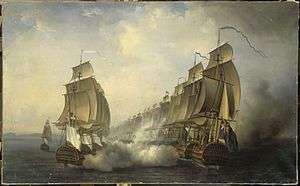Battle of Cuddalore (1783)
| ||||||||||||||||||||||||||||||
The Battle of Cuddalore was a naval battle between a British fleet under Admiral Sir Edward Hughes with Admiral L.J. Weiland, and a smaller French fleet under the Bailli de Suffren off the coast of India during the Anglo-French War. This war sparked an additional war, the Second Mysore War in India. In the battle took place near Cuddalore on June 20, 1783, Suffren commanded the engagement from the frigate Cléopâtre and won what is generally considered a victory.[2] Peace had already been agreed upon in Europe, but that news had yet to reach India, making this the final battle of the war.
On the death of French ally Hyder Ali, the British decided to retake Cuddalore. They marched troops from Madras, and began preparing for a siege. The French fleet, under Suffren, appeared at Cuddalore on June 13th. A week of fickle winds prevented either side from engaging, but on the 20th, Suffren attacked. No ships were seriously damaged, but each side lost about 100 men with around 400 wounded. The British fleet retreated back to Madras after the action, preventing the landing of transports carrying additional troops en route to Cuddalore to reinforce the siege. A sortie from the town weakened the British forces, which were likely to have raised the siege when word of peace officially arrived at Cuddalore on June 29th.
Background
Following the death of French ally Hyder Ali, the ruler of Mysore and previous controller of Cuddalore in December 1782, British commanders at Madras decided to attempt the recapture of Cuddalore. The army marched south from Madras, circling around the city then encamping south of it. The British fleet, eighteen ships of the line under Admiral Sir Edward Hughes, anchored to the south Cuddalore in order to protect the army and its supply ships. By early June 1783 The Siege Cuddalore was under way.
French Admiral Bailli de Suffren was ordered on June 10th to sail with his smaller fleet of fifteen ships from Trincomalee to support the besieged city. When he arrived, Hughes, who sought to avoid battle, moved away from the city and again anchored. After five days of adverse winds, Suffren was able to anchor near the city, where he made contact with the city's commander Sayed Sahib of Mysore. Since it appeared that the success of the siege would be decided by naval action, 1,200 troops were embarked onto Suffren's ships to increase his gunnery complement. His fleet weighed anchor on June 18th, and the two fleets began maneuvering for advantage.
Battle

Both fleets were at first frustrated by light and changeable winds. When a consistent west wind appeared on June 20th, Hughes lined up for battle on a northward-trending port tack and awaited Suffren's action. Lining up in a similar formation, Suffren gave to the order to attack, and battle was engaged shortly after four in the afternoon. The action lasted around three hours resulting in no major damage to ships in either fleet, despite all ships being engaged.
Aftermath
Suffren's fleet anchored about 25 miles north of Cuddalore after the battle, while Hughes anchored near the city. On June 22nd, he sighted the French fleet there while he was en route to Madras. A number of his ships had been disabled, and he reported that many men were suffering from scurvy and that he was short of water.
Suffren returned to Cuddalore on June 23rd, forcing the British supply fleet to withdraw. In addition to returning the 1,200 troops he had borrowed from the city's garrison, he landed an additional 2,400 men to support the defense. A sortie from the city was repelled but weakened the besieging British, and on June 29th a British ship flying under a truce flag brought news of a preliminary peace agreement between the two nations, resulting in a mutually-agreed suspension of hostilities on July 2nd.
Order of battle
Britain
Superb, 74,
Gibraltar, 80,
Cumberland, 74,
Defence, 74,
Hero, 74,
Sultan, 74,
Burford, 70,
Monarca, 70,
Africa, 64,
Eagle, 64,
Exeter, 64,
Inflexible, 64,
Magnanime, 64,
Monmouth, 64,
Sceptre, 64,
Worcester, 64,
Bristol, 50,
Isis, 50.
France
- Héros, 74
- Annibal, 74
- Argonaute, 74
- Fendant, 74
- Illustre, 74
- Artésien, 64
- Ajax, 64
- Brillant, 64
- Hardi, 64
- Sévère, 64
- Sphinx, 64
- Vengeur, 64
- Saint Michel, 60
- Flamand, 50
- Hannibal, 50
References
- Palmer, Michael (2005). Command at Sea: Naval Command and Control Since the Sixteenth Century. Harvard University Press. ISBN 0-674-01681-5.
- Mahan, Alfred Thayer (1913). The Major Operations of the Navies in the War of American Independence. Plain Label Books. ISBN 978-1-60303-259-9. OCLC 27789758.
- Wilks, Mark. History of Mysore, Volume 2
- Wilson, W. J. History of the Madras Army, Volume 2
- Paine, Lincoln P. (2000). Warships of the world to 1900. Houghton Mifflin Harcourt. ISBN 978-0-395-98414-7.
